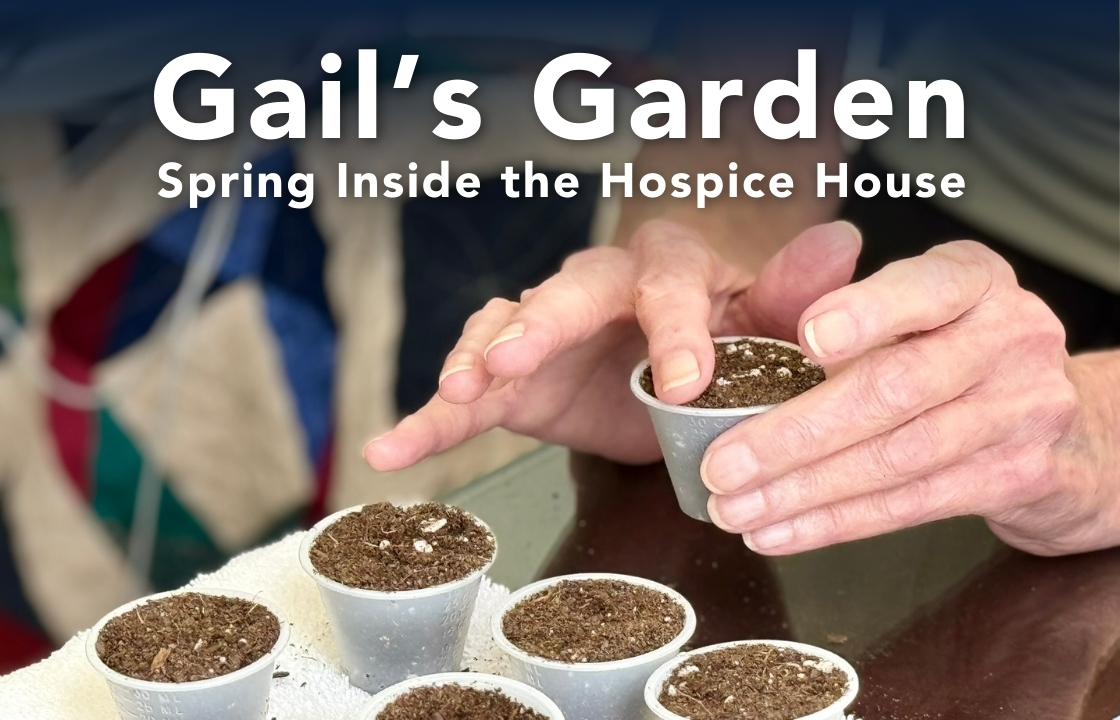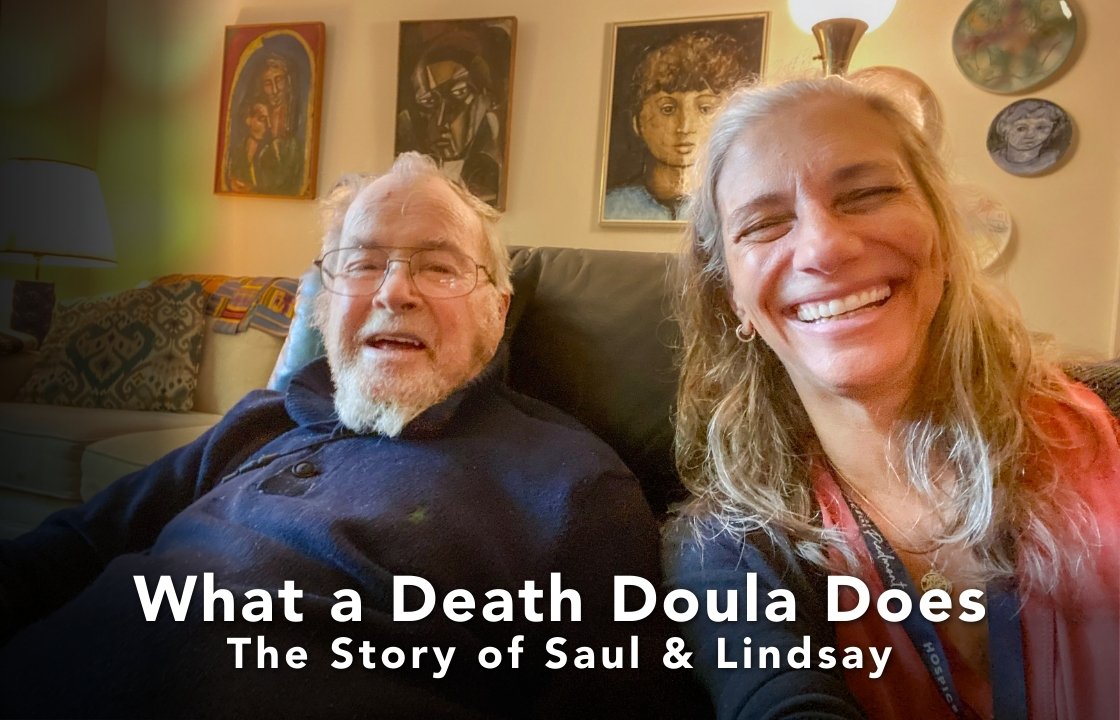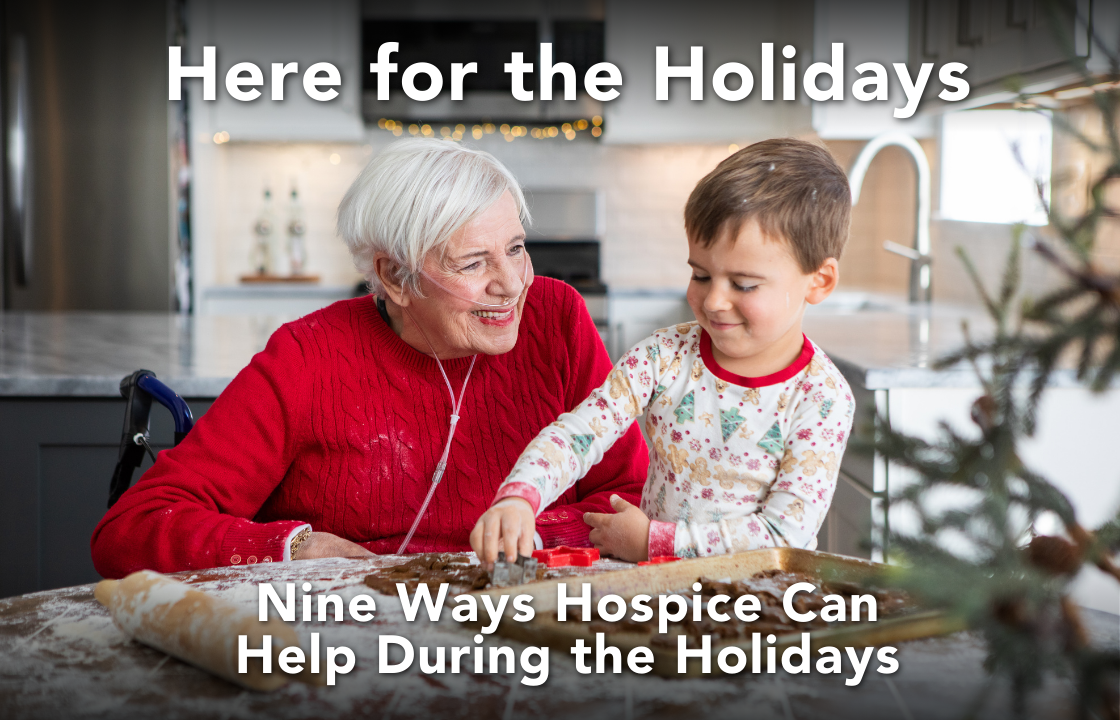You’d think they’d try to keep dirt outside of the hospice house.
But here was Lizzy, with two bags of it.
It was early March, still chilly outside, but the windows in Gail’s room faced south and caught every ray of afternoon sun. The warmth hung in the air, making her room feel like a greenhouse.
Lizzy—an LPN at the Newton & Wilma Thomas Hospice House—set a plastic tub on the nightstand and began mixing two kinds of soil together. Next to her sat 24 small Dixie cups, and Gail, a patient, upright in her bed, observing Lizzy’s game plan.
They’d been talking about gardening for weeks. Gail had always loved flowers; she supposed it was her grandmother’s influence. Lizzy had started growing vegetables from seed the year before. That was all it took.
“I told her I never tried growing flowers from seeds,” Gail says. “Well, I did one time. One time was enough to tell me I didn’t want to do that again.” She laughs.
Lizzy hatched a plan. She’d bring in the seeds. Gail could help plant them. They’d turn a plastic storage bin into a makeshift greenhouse and watch for sprouts.
Gail was persuaded. “So, this will be an exercise for me. It’s not like I’m doing a lot of other things,” she says half-jokingly.
“We’re going to start a flower garden,” Lizzy says, smiling. “A little flower garden. From seed.”
The Hospice House is an astonishing place.
People have a way of connecting here. After all, you’re in someone’s house. Whose house? That’s hard to say. Is it the patient’s house? Or the staff’s house? Somehow, it’s a place that belongs to everyone. Everyone is a resident and a guest.
Gail and Lizzy chat like old friends.
There’s a familiarity and closeness in the way they talk to one another. The transcript of their conversation reads like an Aaron Sorkin show – but with a bedside manner. Rapid, teasing, intimate. They have patter.
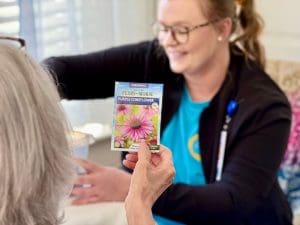
Lizzy measures soil into the cups while Gail checks out the seeds. They are planting four types of flowers: daisies, sunflowers, purple coneflowers, and Gail’s favorite, a white coneflower variety called White Swan Echinacea.
“The cone is what changes,” Gail explains. “You could have 20 of them and every one would look different.” She points to the seed packet. “See. Different sizes. Some of them are flat, some of them are round, others look a little pointy, almost. They get some really interesting shapes.”
She should know. Before she moved into the hospice house, Gail’s yard was full of flowers. She showed Lizzy pictures once — “She pulled out the receipts,” Lizzy chuckles.
“I’m actually into instant gratification,” Gail admits. “That’s another case for not going with seeds. You go and you get the plants.”
She shook a few seeds into her hand. “These are like babies. Little peanuts that grow up – like us.”
They work chattily, side by side. Lizzy fills the cups with soil and makes a perfectly centered hole in each cup with the tip of a capped pen.
Gail is telling a story when she realizes Lizzy has moved ahead in the planting without telling her.
“What are you doing? What did you do without me?” she asks.
“I just dropped seeds in here,” explains Lizzy.
Gail deadpans, “I didn’t see you do it. Go back, take them out, and put them back in.”
“Not quite,” Lizzy replies, giggling.
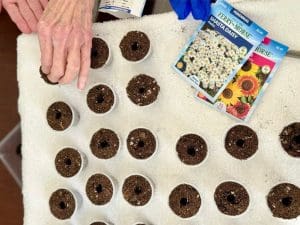
They each carefully drop seeds into the soil.
Some will sprout in a week. Others might take longer. When they grow big enough, Lizzy will transplant them to her own garden. And when the time is right, she’ll bring one back—a White Swan Echinacea, in bloom.
“We’ll start them in these cups and use this tub as the greenhouse,” Lizzy says, patting the plastic tub. “I figured it would be easier if we needed to move them or add moisture.”
Gail’s history with Hospice of the Piedmont began long before she became a patient. In 2018, her husband died in hospice care at the Center for Acute Hospice Care. In 2021, her stepfather passed away with hospice care at home. Twelve years ago, her mother died across the hall.
Imagine that.
Gail came to the Hospice House in January, and despite, or perhaps because of, all she’d been through—hospital stays, a terrifying night in assisted living—she said, “I was so happy to come here.”
“This place feels so safe. So friendly.”
With the help of a friend, she’d spent those early days trying to get her affairs in order: preparing to sell the house, handling paperwork, and—perhaps most importantly—finding a forever home for her beloved cat, Izzy.
“I have a real hard time not calling Lizzy, Izzy,” she teases.
It wasn’t until she knew Izzy would be loved that she could be at peace. A local rescue organization called “Cat Action Team” (or CAT) found Izzy a foster home.
“He was a feral. It took me a year to get him into the house,” she remembers.
But Izzy adapted to his new house, too. He adapted so well that his foster mom adopted him. She reported that Izzy was in bed with two other cats and his foster mom.
“Everybody was happy.”
A few months ago, someone sent a thank-you note describing the Hospice House as “this waiting room between two worlds.”
Today, the waiting room smells like potting soil.
“I can house them,” Gail says, gesturing toward the cups. “And just talk to them nicely.”
“You have to say nice things,” says Lizzy earnestly.
“I can do that.”
And she did.
“Welcome to your new home. Your temporary home. Someday you’re going to go to a beautiful garden.” And then, in a whisper, “Enjoy life. You’ll be loved, and you’ll give love. These are all good things.”
Lizzy labeled the cups, row by row. Six for coneflowers. Six for daisies. Six for sunflowers. And six for the White Swan Echinacea.
The soil was moist. The room was warm. The light was strong.
“I did my part,” Gail said.
Outside, the trees were still bare. But inside the Hospice House, 24 tiny seeds were already deciding on spring.
